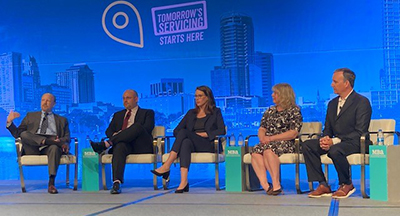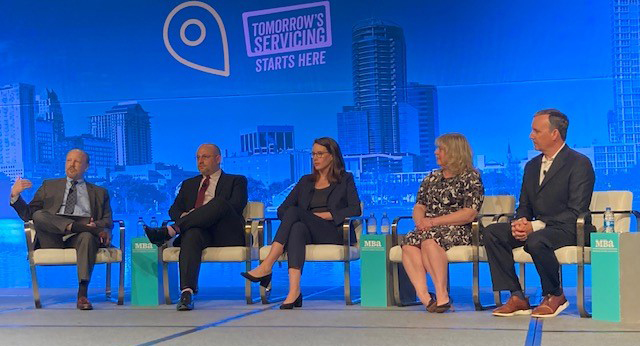
Servicing22: Building Resiliency for Crisis Preparedness

ORLANDO—Perhaps more than any other segment of the real estate finance industry, mortgage servicing had to adapt to the impact of the coronavirus pandemic.
“The past 15 years have taught us the important of preparedness,” said Pete Mills, MBA Senior Vice President of Residential Policy and Strategic Industry Engagement, speaking here at the MBA Servicing Solutions Conference & Expo. “We’ve learned to adapt from natural disasters, but COVID threw us a new loop. We have had to adapt quickly and become more agile to serve our customers.”
“COVID was a different beast at first,” said Ben Gottheim, Senior Director for Mortgage Servicing Policy with Freddie Mac, McLean, Va. “The unemployment numbers shot up quickly and we weren’t sure how long it would last. The mortgage industry has had a number of ‘hundred-year events’ in the past couple of years. And we were as an industry able to adapt quickly—the industry, policymakers, even Congress.”

Gottheim said the industry reacted “really quickly, and really well. We shifted from an office environment to having call centers in peoples’ houses—all that happened in a matter of weeks, and it is a testament to our ability to adapt.”
Janet Jozwik, Managing Director with RiskSpan, Washington, D.C., said the industry was “lucky” as well. “Our customers had a lot of questions,” she said. “We had to provide data to our customers in ways we had never done before. We had to come up with creative solutions quickly to help our customers adapt.”
“Making it up on the fly is something all of us can relate to, now,” said Carolyn Lese, Director with PwC, Chester Springs, Pa. “Servicers had a lot of these programs in place. Forbearance was in place. We already had the foundation for success.”
“Business continuity allowed us to be this nimble,” said Stephen Staid, Executive Vice President of Mortgage Practice Strategy with SourcePoint, Lewisville, Texas. “If this had happened 20 years ago, I doubt our response would have or could have been the same.”
Staid said communication involved three segments: customers, employees and investors. “They all require different strategies,” he said. “When we changed from the office to work from home, we had to change our entire management approach. You have to have a discipline in place to do things simultaneously to get it right.”
“Now that we’re two years post-COVID onset, you have to take a new look at your continuity plans,” Lese said. “And it goes beyond your teams—it goes to your third-party providers and others. We got a lot of things right, but a lot of things went wrong, too.”
“We are looking at where we can do things better so that we can respond even better next time,” Jozwik said.”
“We thought we knew what we were going to go when COVID hit; and in the first three weeks we issued new bulletins basically saying, ‘don’t pay attention to what we said previously,’” Gottheim said. “Having the right mentality in our company enabled us to respond and adapt quickly.”
Freddie Mac runs numerous scenarios over the course of a year, such as hurricanes, wildfires—and now, pandemics. “Each scenario is different,” Gottheim said. “We try to test things out in a number of ways, not only just to help our customers but also to assess the impact on us.”
“What I’m seeing when I talk to my clients, is that they are testing—but the testing is only as good as how it’s been updated,” Lese said. “We are encouraging our clients to do more scenario-based testing so that they are better prepared.”
Gottheim noted during the early phase of COVID, some of its weekly calls with servicers had hundreds of organizations participating. “It was important for us to hear what was happening at the servicer level,” he said. “It helped us work through solutions that were best for the industry. Our goal was to benefit every link in the chain—you can’t always get it that way, but communication allowed us to close the gaps where we could.”
Looking ahead, panelists said technology will play a dominant role in crafting solutions. “We’re trying to pull in data and analytics that are primarily serving the modeling industry into our space,” Jozwik said. “It will help us with our processes.”
“What the pandemic really brought to the forefront was the need for technology to help us change,” Lese said. “We learned that the best communication to our customers was to get things to them as quickly as possible, and we need technology to make that happen.”
“The pandemic did a good job of laying out how important it is to fill the gaps, and I’m not sure the servicing industry has that level of sophistication,” Staid said. “We need to be able to pivot, so that we can deliver communication, data and services that much faster and efficiently.”
“We need to be able to do what we do every day, and adapt as things happen,” Gottheim said. “It’s not about getting to the next crisis—it’s about having it in place and tweaking as things change.”
“Servicing is a different business from originations,” Lese said. “It’s not an easy question as to how to transform it, because the opportunity is there to have a transformative servicing experience—and I’m not sure any of us know how to get there yet.”
Mills noted federal and state government agencies taking a harder look at climate change and suggested it could have an impact on how mortgage servicers develop future strategies.
“It’s not going to be about the mortgage industry addressing future climate risk; it’s going to be about the industry reacting to how climate risk changes,” Gottheim said.
“The real question is when is the threat of climate risk going to directly affect borrowers,” Jozwik said. “When a property can no longer be insured because of climate risk, then we’ll start to see some real changes in approach.”
